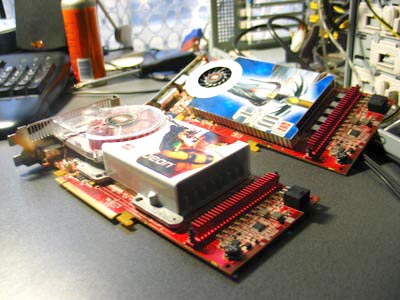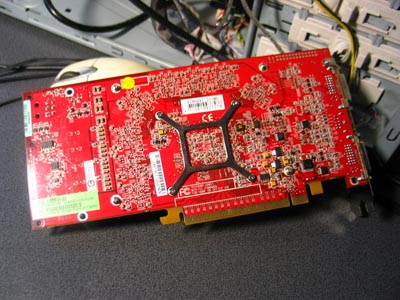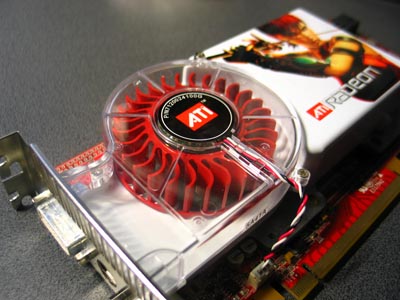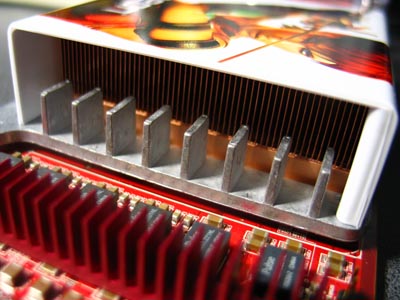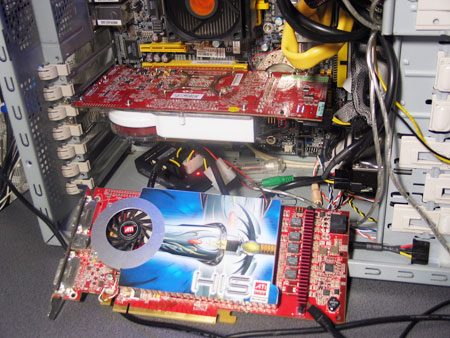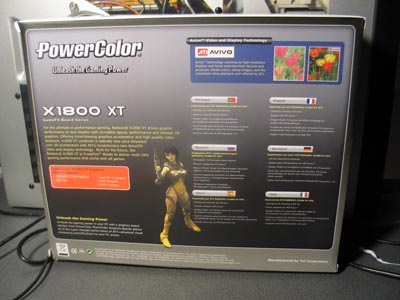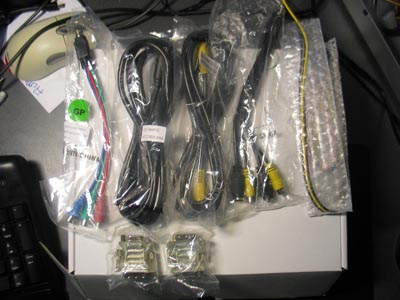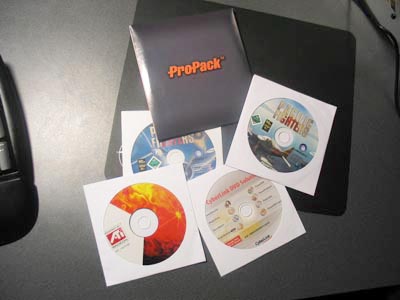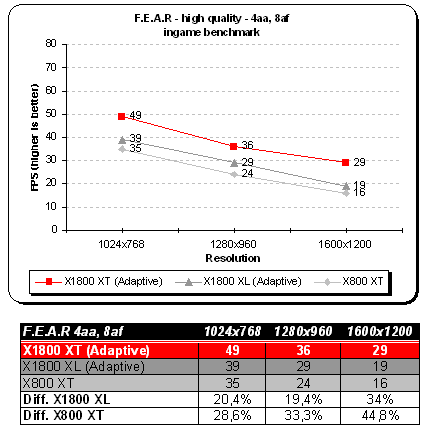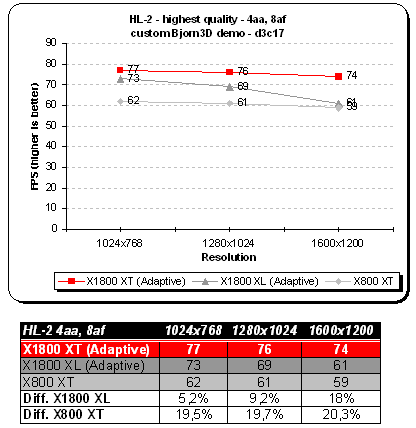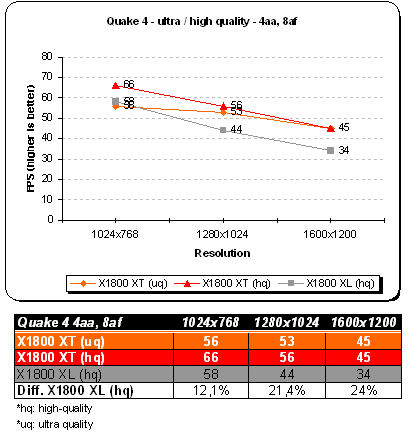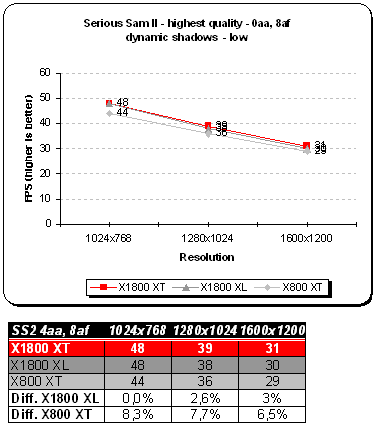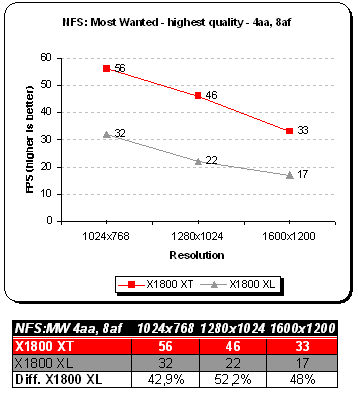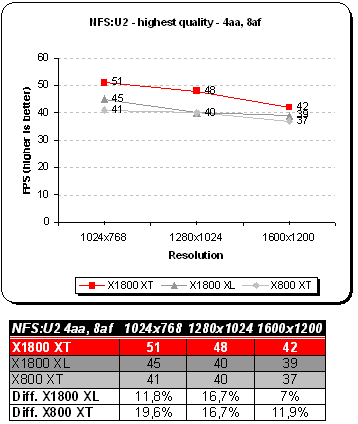Check out our review of PowerColor’s flagship video card – the X1800 XT VIVO. With 512MB of memory and an advanced architecture, it promises great performance. See if it delivers!
Introduction
Things have been heating up with the late introduction of X1K graphics cards from ATi. NV4X & R42X ASICs were going head to head for the most part. In some benchmarks however 6800 Ultra took the crown from X850 XT and vice versa. The most discussed and apparent reasons for R520 being late were production problems. The majority of chips did not pass high clockrate tests. Failures in sillicon were random and not known for a long period of time. Once the problem was narrowed down to 3rd party IPs crippled design, GPUs started to yield proper clockrates. This goes to show you how a small flaw can contribute to massive delays.
Okay enough of the past, let’s concentrate on our product. Should you require more detailed information on R520 please revisit our article: The X1000 series – ATI goes SM3.0
What we have in our lab this week is a PowerColor X1800 XT video card. Starting from R300, Tul (the owner of PowerColor brand) has been ATi’s very active partner. They make top to bottom cards at a competitive price. It’s been around two-three weeks since first X1800 boards appeared on the market. Due to the lack of components, Tul got in a bit late into the game with their X1K series (especially XL which we haven’t received at the time of the launch). If you look around however, you’ll find quite a few PowerColor X1800 cards — either XT (256/512 version) or XL.

PowerColor is a consumer brand focused on providing cutting-edge graphics card products to retail customers. Our goal for the Tul brand is to be the industry’s number one provider of technology product solutions. Our goal for the PowerColor brand is to be the world’s number one brand of graphics cards. PowerColor is in effect owned by Tul Corporation, however the brands are operated independently of each other.
VPU Specifications
As with every new generation of GPUs the feature set becomes larger and more complex. The newly introduced X1K family of products is exactly what we have here. Most importantly, the X1000 line now sports Shader Model 3.0 which has been available from NVIDIA for over a year now. As you can see from the table below, X1800 XT is built around 90nm sillicon — so are mid-end and low-end chips. Due to inclusion of SM3.0, brand new memory controller, improved cache design and Z-buffer, transistor count has doubled compared to R420. ATi’s R520 now has 321 million of those electronic switches.
The biggest of all changes is the introduction of what ATi calls Ultra-Threading Dispatch Processor and Ring Bus (old SMARTSHADER). Without going into much detail here, the dispatch processor (as the name implies) routes or relegates the workload to four pixel shader cores (also known as Quads). Each quad consists of four mini-pixel processors. The process between them is called threading and means:
- Large Scale Multi-threading
- Hundreds of simultaneous threads across multiple cores
- Each thread can perform up to 6 different shader instructions on 4 pixels per clock cycle
- Small Thread sizes
- 16 pixels per thread in Radeon X1800
- Fine-grain parallelism
- Fast Branch Execution
- Dedicated units handle flow control with no ALU overhead
- Large Multi-Ported Register arrays
- Enables fast thread switching
Now the Ring Bus technology. This isn’t Marry-go-around or anything like that — well sort of. The bus itself consists of two 256-bit rings which run in the opposite direction. This way routing latencies are reduced to a bare minimum and clockrate scaling is far more efficient. Among other things we have:
- New cache design – fully associative for more optimal performance
- Improved Hyper-Z – better compression and hidden surface removal
- Programmable arbitration logic – maximizes memory efficiency and can be upgraded via software
| Video card |
PowerColor X1800 XT |
HiS X1800 XL |
ATi X800 XT | PowerColor X800XL |
| GPU (256-bit) | R520 | R420 | R420 | R430 |
| Chip Architecture | .09µ (TSMC fab) |
.09µ (TSMC fab) | .13µ (TSMC fab) | .11µ (TSMC fab) |
| Transistors | ~321 Million | ~320 Million | ~160 Million | ~160 Million |
| Memory Architecture | 256-bit |
256-bit | 256-bit | 256-bit |
| Frame Buffer Size | 512 MB GDDR-3 |
256 MB GDDR-3 | 256 MB GDDR-3 | 512 MB GDDR-3 |
| Pixel Pipelines | 16 (4 quads) |
16 (4 quads) |
16 (4 quads) | 16 (4 quads) |
| Vertex Pipelines | 8 | 8 | 6 | 6 |
| TMU(s) per Pipeline | 1 | 1 | 1 | 1 |
| Engine | Ultra-threaded architecture |
SMARTSHADER HD | SMARTSHADER HD | SMARTSHADER HD |
| Bus Type | PCI-e 16x |
PCI-e 16x | PCI-e 16x | PCI-e 16x |
| Core Clock | 600 MHz | 500 MHz | 500 MHz | 400 MHz |
| Memory Clock | 1500 MHz DDR |
1000 MHz DDR | 1000 MHz DDR | 980 MHz DDR |
| RAMDACs | 2x 400 MHz DACs | 2x 400 MHz DACs | 2x 400 MHz DACs | 2x 400 MHz DACs |
| Memory Bandwidth | 48 GB / sec | 32 GB / sec | 32 GB / sec | 31.4 GB / sec |
| Pixel Fillrate | 10 GPixels / sec |
8 GPixels / sec | 8 GPixels / sec | 6.4 GPixels / sec |
| Texel Fillrate | 10 GTexels / sec |
8 GTexels / sec | 8 GTexels / sec | 6.4 GTexels / sec |
| DirectX Version | 9.0c | 9.0c | 9.0c | 9.0c |
| Pixel Shader | 3.0 | 3.0 | 2.0b | 2.0b |
| Vertex Shader | 3.0 |
3.0 | 2.0 | 2.0 |
Features:
-
- 321 million transistors on 90nm fabrication process
- Ultra-threaded architecture with fast dynamic branching
-
16 pixel shader processors
- 8 vertex shader processors
- 256-bit 8-channel GDDR3/GDDR4 memory interface
- Native PCI Express x16 bus interface
- Dynamic Voltage Control
- Ring Bus Memory Controller
-
- 512-bit internal ring bus for memory reads
- Programmable intelligent arbitration logic
- Fully associative texture, color, and Z/stencil cache designs
- Hierarchical Z-buffer with Early Z test
- Lossless Z Compression (up to 48:1)
- Fast Z-Buffer Clear
- Z/stencil cache optimized for real-time shadow rendering
- Optimized for performance at high display resolutions, including widescreen HDTV resolutions
- Ultra-Threaded Shader Engine
-
- Support for Microsoft® DirectX® 9.0 Shader Model 3.0 programmable vertex and pixel shaders in hardware
- Full speed 128-bit floating point processing for all shader operations
- Up to 512 simultaneous pixel threads
- Dedicated branch execution units for high performance dynamic branching and flow control
- Dedicated texture address units for improved efficiency
- 3Dc+ texture compression
- High quality 4:1 compression for normal maps and two-channel data formats
- High quality 2:1 compression for luminance maps and single-channel data formats
- Multiple Render Target (MRT) support
- Render to vertex buffer support
- Complete feature set also supported in OpenGL® 2.0
- Advanced Image Quality Features
-
- 64-bit floating point HDR rendering supported throughout the pipeline
- Includes support for blending and multi-sample anti-aliasing
- 32-bit integer HDR (10:10:10:2) format supported throughout the pipeline
- Includes support for blending and multi-sample anti-aliasing
- 2x/4x/6x Anti-Aliasing modes
- Multi-sample algorithm with gamma correction, programmable sparse sample patterns, and centroid sampling
- New Adaptive Anti-Aliasing feature with Performance and Quality modes
- Temporal Anti-Aliasing mode
- Lossless Color Compression (up to 6:1) at all resolutions, including widescreen HDTV resolutions
- 2x/4x/8x/16x Anisotropic Filtering modes
- Up to 128-tap texture filtering
- Adaptive algorithm with Performance and Quality options
- High resolution texture support (up to 4k x 4k)
- Avivo™ Video and Display Platform
-
- High performance programmable video processor
- Accelerated MPEG-2, MPEG-4, DivX, WMV9, VC-1, and H.264 decoding and transcoding
- DXVA support
- De-blocking and noise reduction filtering
- Motion compensation, IDCT, DCT and color space conversion
- Vector adaptive per-pixel de-interlacing
- 3:2 pulldown (frame rate conversion)
- Seamless integration of pixel shaders with video in real time
- HDR tone mapping acceleration
- Maps any input format to 10 bit per channel output
- Flexible display support
- Dual integrated dual-link DVI transmitters
- DVI 1.0 compliant / HDMI interoperable and HDCP ready
- Dual integrated 10 bit per channel 400 MHz DACs
- 16 bit per channel floating point HDR and 10 bit per channel DVI output
- Programmable piecewise linear gamma correction, color correction, and color space conversion (10 bits per color)
- Complete, independent color controls and video overlays for each display
- High quality pre- and post-scaling engines, with underscan support for all outputs
- Content-adaptive de-flicker filtering for interlaced displays
- Xilleon™ TV encoder for high quality analog output
- YPrPb component output for direct drive of HDTV displays
- Spatial/temporal dithering enables 10-bit color quality on 8-bit and 6-bit displays
- Fast, glitch-free mode switching
- VGA mode support on all outputs
- Drive two displays simultaneously with independent resolutions and refresh rates
- Compatible with ATI TV/Video encoder products, including Theater 550
- CrossFire™
-
- Multi-GPU technology
- Four modes of operation:
- Alternate Frame Rendering (maximum performance)
- Supertiling (optimal load-balancing)
- Scissor (compatibility)
- Super AA 8x/10x/12x/14x (maximum image quality)
The Card
The physical dimensions of PowerColor X1800 XT are exactly the same as ATi’s reference design. Even more, the sticker does not inform you about the brand; you can see a radial type fan slapped onto the copper plate without any branding ie. default ATi logo. An interesting tidbit, all flagship cards are built over at Foxconn and Celestica fabs to ensure maximum quality.
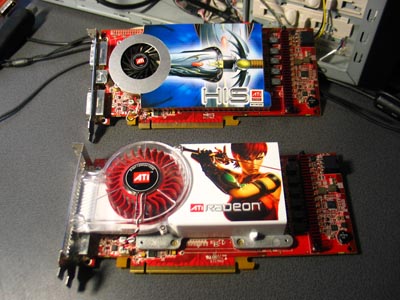
PowerColor X1800 XT features Avivo technology:
- Avivo™ Video and Display Platform
-
- High performance programmable video processor
- Accelerated MPEG-2, MPEG-4, DivX, WMV9, VC-1, and H.264 decoding and transcoding
- DXVA support
- De-blocking and noise reduction filtering
- Motion compensation, IDCT, DCT and color space conversion
- Vector adaptive per-pixel de-interlacing
- 3:2 pulldown (frame rate conversion)
- Seamless integration of pixel shaders with video in real time
- HDR tone mapping acceleration
- Maps any input format to 10 bit per channel output
- Flexible display support
- Dual integrated dual-link DVI transmitters
- DVI 1.0 compliant / HDMI interoperable and HDCP ready
- Dual integrated 10 bit per channel 400 MHz DACs
- 16 bit per channel floating point HDR and 10 bit per channel DVI output
- Programmable piecewise linear gamma correction, color correction, and color space conversion (10 bits per color)
- Complete, independent color controls and video overlays for each display
- High quality pre- and post-scaling engines, with underscan support for all outputs
- Content-adaptive de-flicker filtering for interlaced displays
- Xilleon™ TV encoder for high quality analog output
- YPrPb component output for direct drive of HDTV displays
- Spatial/temporal dithering enables 10-bit color quality on 8-bit and 6-bit displays
- Fast, glitch-free mode switching
- VGA mode support on all outputs
- Drive two displays simultaneously with independent resolutions and refresh rates
- Compatible with ATI TV/Video encoder products, including Theater 550
Let’s go over the bundle shall we?
Bundle
In terms of package and bundle you’ll find a standard PowerColor box with accessories and software. If you’re looking for new games, you’ll be disappointed. On the other hand you should be happy with included cabling.
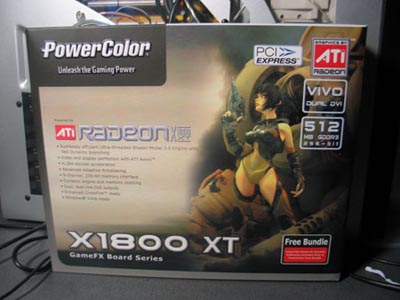
- Accessories
- HDTV Cable
- Video in/out Cable
- S-Video Cable
- Composite Cable
- 2 DVI-I connectors
- PCI-e power cable
- Driver CD
- CyberLink DVD Solutions
- PowerDVD 5
- PowerProducer 2 Gold DVD
- PowerDirector 3
- Power2Go 3
- Medi@show 2
- Pacific Fighters full game
- Pacific Fighters Multi-Language Hot-Key Reference
Setup and Installation
All of our benchmarks were ran on Athlon64 3000+ system with two different clocks: default and 2.5GHz. The reason I decided to up the CPU clock for R520 is the fact it would be limiting the cards by a whole lot. It still is limiting at low resolutions in some benchmarks, but I’ve tried to create as little bottlenecked environment as possible. I will stack PowerColor X1800 XT against HiS X1800 XL and reference design ATi X800 XT. The table below shows test system configuration as well benchmarks used throughout the review.
| Components | – DFI NF4 Ultra-D – Athlon64 3000+ Venice – 2x256MB Corsair PC3200LLP (Dual Channel) – Thermaltake 520 Watt PSU – PowerColor X1800 XT 512 MB – HiS X1800 XL – ATi X800 XT |
| Software | – Windows XP SP2 – DirectX 9.0c – nForce4 6.53 drivers – CATALYST 5.11 |
| Synthetic Benchmarks | – 3DMark 2005 v1.2.0 – D3D Right Mark 1.0.5.0 beta 4 |
| Gaming Benchmarks | – F.E.A.R / ingame benchmark + Fraps – Half-Life 2 / custom d13c17 timedemo + Fraps – Doom 3 / default timedemo + Fraps – Quake 4 / custom timedemo – Serious Sam II / Fraps – NFS: Most Wanted / Fraps – NFS: Underground 2 / Fraps – Far Cry 1.32 / custom timedemo + Fraps |
| Notes | For R420 CPU was clocked at default 1.8GHz For R520 CPU was clocked at 2.5GHz to reduce limitation |
I haven’t had any problems fitting our X1800 XT inside my system. As you can see from below picture, the board requires 2 free slots. The PCB is quite long so make sure your hard drive is pushed all the way up to the front, otherwise you might have a problem.

PowerColor X1800 XT inside the case will take a bit of room so make sure you have plenty of it
Synthetic Benchmarks
3DMark05
I’ve used Futuremark’s 3DMark 2005 to measure the actual throughput of PowerColor X1800 XT and compared it against X1800 XL, X850 XT PE as well as reference X800 XT.
| Video card |
PowerColor X1800 XT | HiS X1800 XL |
PowerColor X850 XT PE
|
ATi X800 XT
|
|
| Pixel Fillrate | 4992 MPixels / sec |
3412 MPixels / sec |
3654 MPixels / sec
|
3284 MPixels / sec
|
|
| Texel Fillrate | 9783 MTexels / sec | 7935 MTexels / sec |
8542 MTexels / sec
|
7943 MTexels / sec
|
|
| Geometry Rate | 620 MTriangles | 500 MTriangles |
540 MTriangles
|
500 MTriangles
|
|
| Vertex Shader – Simple | 87 MVertices / sec | 70 MVertices / sec |
62 MVertices / sec
|
58 MVertices / sec
|
|
| Vertex Shader – Complex | 57 MVertices / sec | 47 MVertices / sec |
50 MVertices / sec
|
46 MVertices / sec
|
|
| Pixel Shader (2.0b) | 232 FPS | 185 FPS |
155 FPS
|
140 FPS
|
Looking at synthetic performance it reveals quite good throughput scores at 620 MHz (core). Pixel fillrate reaches almost 5000 marks and Pixel Shader 2.0 results max out at 232 FPS.

With D3D RightMark you will be able to get the following information about your video card:
- Features supported by your video card
- Pixel Fillrate and Texel Fillrate
- Pixel shader processing speed (all shader models)
- Vertex shader (geometry) processing speed (all shader models)
- Point sprites drawing speed
- HSR efficency
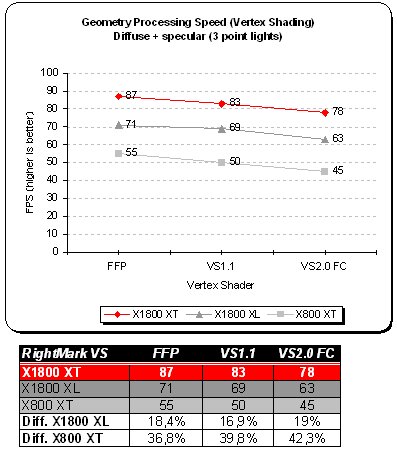
The new line of X1K video cards do nicely in all three tests: X1800 XT ends up with 87 FPS (FFP), 83 FPS (VS1.1) and 78 FPS (VS2.0 flow control). Percentage wise, it’s better than its predecessor by around 40%
F.E.A.R
On August 5th this year, VUGames have released F.E.A.R demo to the public. The game is being made over at Monolith Productions studio and should be out later this year. Since almost everyone has been waiting for this demo, I’ve decided to give it a shot and bench it with our X800 GT.
Texture caching in retail F.E.A.R has been improved a little. You won’t see a lot of chugging when abruptly turning around. Our benchmarking method was simple. I used default F.E.A.R benchmarking utility which nicely shows all effects and technology used throughout the game.
Game Overview
An unidentified paramilitary force infiltrates a multi-billion dollar aerospace compound, taking hostages but issuing no demands. The government responds by sending in special forces, but loses contact as an eerie signal interrupts radio communications. When the interference subsides moments later, the team has been obliterated. As part of a classified strike team created to deal with threats no one else can handle, your mission is simple: Eliminate the intruders at any cost. Determine the origin of the signal. And contain the crisis before it spirals out of control.
As you probably know, F.E.A.R uses a very sophisticated game engine (FEAR).
- Rendering
- FEAR is powered by a new flexible, extensible, and data driven DirectX 9 renderer that uses materials for rendering all visual objects. Each material associates an HLSL shader with artist-editable parameters used for rendering, including texture maps (normal, specular, emissive, etc.), colors, and numeric constants.
- Lightning Model
- FEAR features a unified Blinn-Phong per-pixel lighting model, allowing each light to generate both diffuse and specular lighting consistently across all solid objects in the environment. The lighting pipeline uses the following passes:
- Emissive: The emissive pass allows objects to display a glow effect and establishes the depth buffer to improve performance.
- Lighting: The lighting pass renders each light, first by generating shadows and then by applying the lighting onto any pixels that are visible and not shadowed.
- Translucency: The translucent pass blends all translucent objects into the scene using back to front sorting.
- FEAR features a unified Blinn-Phong per-pixel lighting model, allowing each light to generate both diffuse and specular lighting consistently across all solid objects in the environment. The lighting pipeline uses the following passes:
- Visual Effects
- FEAR features a new optimized, data driven effects system that allows for the creation of key-framed effects that can be comprised of dynamic lights, particle systems, models, and sounds. Examples of the effects that can be created using this system include weapon muzzle flashes, explosions, footsteps, fire, snow, steam, smoke, dust, and debris.
- Sample Lights
- FEAR’s lighting model is very flexible and allows developers to easily add new lights. Existing lights include:
- Point Light: The point light is a single point that emits light equally in all directions.
- Spotlight: Similar to a flashlight, the spotlight projects light within a specified field of view. The spotlight can also use a texture to tint the color of the lighting on a per pixel basis.
- Cube Projector: Similar to the point light, the cube projector uses a cubic texture to tint each lit pixel.
- Directional Light: This lighting is emitted from a rectangular plane and is used to simulate directional lights like sunlight.
- Point Fill: Although similar to the point light, the point fill is an efficient option because it does not utilize specular lighting or cast shadows.
- FEAR’s lighting model is very flexible and allows developers to easily add new lights. Existing lights include:
A more detailed overview of other F.E.A.R technologies can be found over at Touchdown Entertainment. These include: Havok Physics Engine and Modeling / Animations System.
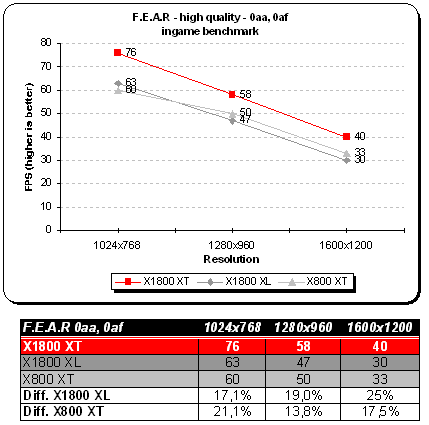
Half-Life 2
We all love Half-Life 2 and we all want best performance out of our hardware. This has to be one of the most graphic demanding games currently on the market. Half-Life 2 is built around Source engine which utilizes a very wide range of DirectX 8 / 9 special effects. Those include:
- Diffuse / specular bump mapping
- Dynamic soft shadows
- Localized / global valumetric fog
- Dynamic refraction
- High Level-of-Detail (LOD)
Note that users with DirectX 7 and older hardware (NVIDIA MX series for example) will not be able to enjoy the above effects. Let’s see what PowerColor X1800 XT is made of.

Doom 3
Now that we are past Doom 3s release, some gamers have been left with a bit of disappointment. Main reason is Half-Life 2 and its Source engine which really showed a vast amount of potential and scalability.
Although this game needs no introduction, I will go over some of the game features and technology behind Doom 3. It took the guys at id Software over four years to complete this project. Lead programmer, John Carmack spent an awful lot of time designing the game engine, but his hard work paid off — to some extent since this is first title which houses Doom 3 engine.
Let’s look at some of the engine tech features which are present in Doom 3:
- Unified lightning and shadowing engine
- Dynamic per-pixel lightning
- Stencil shadowing
- Specular lightning
- Realistic bumpmapping
- Dynamic and ambient six-channel audio
However you look at it, Carmack’s lightning engine is the essence of Doom 3. With OpenGL being the primary API, shaders have been put to a heavy use in order to create the realisticly looking environment. Instead of using lightmaps the game engine now processes all shadows in real-time. This technique is called stencil shadowing which can accurately shadow other objects in the scene. There are disadvantage to this method however:
- Requires a lot of fillrate
- Fast CPU is needed for shadow calculations
- Inability to render soft shadows
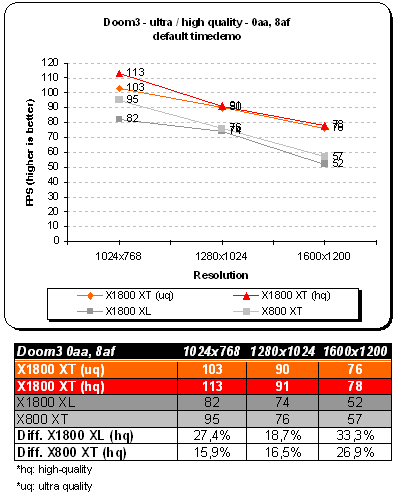
With new CATALYST 5.11, OpenGL titles have been said to run much faster. Here is what ATi has to say:
The ATI Radeon® X1800 has massive gains in OpenGL when 4X Anti-aliasing is enabled. Increases include:
- Doom 3 performance improvement of up to 38%
- Quake 4 performance improvement of up to 60%
- Older OpenGL titles such as Quake 3, Arena, and Wolfenstein: Enemy Territory, have performance improvements of up to 50%
The ATI Radeon® X1300 has a performance improvement of 10-15% in Quake 4.
The Vertex Shader has performance improvement of 3-5% across multiple products.
Although I wasn’t able to test older driver running X1K cards, performance in Doom 3 seems top notch. With 1024×768 Doom 3 runs at 103 FPS (Ultra Quality) and 113 FPS (High Quality). Scores narrow down between those two quality modes when going into 1280×1024 and 1600×1200. Ultra Quality on PowerColor X1800 XT is definitely a worthy step if you want to play with maximum ingame settings. For obvious reasons (256MB) X1800 XL and X800 XT did not like the highest mode therefore scores were not included.
Quake 4
This is another good title worth looking at. With success of Quake 3, id Software decided (after few years) it would be proper to have a sequel. Designed over at Raven Software’s farm, Q4 features rich single player as well as intensive and popular multiplayer mode.
It uses Doom 3 engine so you should be familiar with available effects. In any case, I listed them below
- Unified lightning and shadowing engine
- Dynamic per-pixel lightning
- Stencil shadowing
- Specular lightning
- Realistic bumpmapping
- Dynamic and ambient six-channel audio
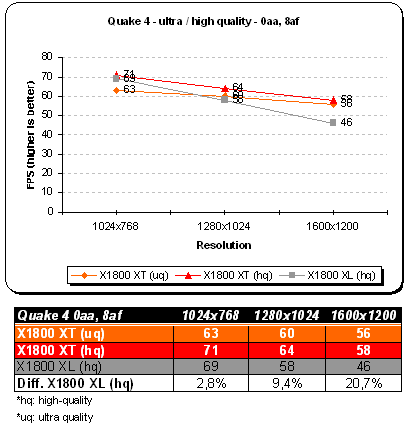
Serious Sam II
A highly anticipated sequel from Croteam has arrived. The madness continues as Sam runs around destroying anything that stands in his way. The environment looks great though level design could have used some more work. Enemies are bigger and there is plenty of action going on. Obviously the rendering engine went through a major redesign. As with previous Sam titles it features OpenGL 3D API which has undergone a full transition.

Need For Speed: Most Wanted
We have quite a few sequels in this review and this is another one, this time from Electronic Arts. If you’ve played NFS Hot Pursuit you know what I’m talking about. There are a lot of ideas taken out from the older NFS. The main difference between Most Wanted and Underground (in terms of graphics) is addition of HDR-type effects. It’s pseudo-HDR (more like bloom), but looks lovely nonetheless. Additionally the game sports flashy new reflections, better object geometry, improved lightning system and finally physics engine.
On the prvious page I showed you how X1K line performs in NFS: Underground 2. Here we have a fresh new title with bells and whistles waiting to get benched.
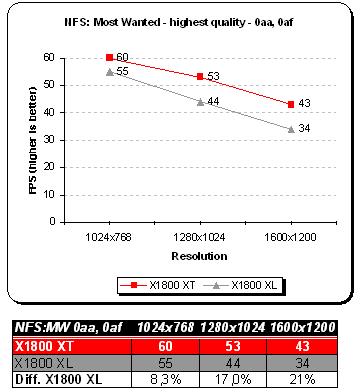
Need For Speed: Underground 2
Another DirectX 9 title with nicely shaped up graphics. The neverending title from EA Sports has brought many plenty of fun as with previous NFS series. The game uses various effects mostly found in Shader Model 2.0 such as motion blur, light / glow trails or reflections. The good thing is, all those effects are compatible when Antialiasing is enabled.
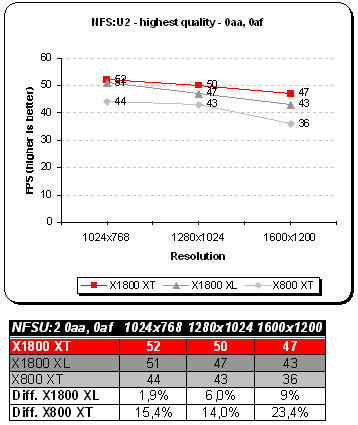
Far Cry 1.32
The company behind this game is Crytek. It was pretty much the first title which used a heavy load of PS 2.0 shaders. For our benching purposes we are using the full version with the newest 1.32 patch applied (mainly fixes SM 3.0 issues that caused graphic corruption on newer ATI hardware). Anyone who played this title will admire the draw distance, beautiful outside vegetation and incredibly spooky indoor environment. The game also features topnotch self-learning A.I and very realistic physics.
Far Cry’s CryEngine is pretty scalable, however you’d need at least DirectX 8 class hardware to enjoy the refractive water effects, ripples, real time per-pixel lighting, specular bump-mapping or volumetric effects.
The map of choice was Research. It’s a high-polygon map with both outdoor and indoor environment.
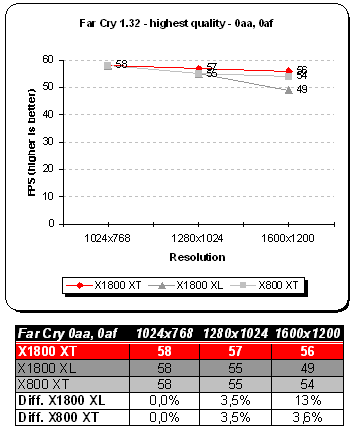
Overclocking and Conclusions
Overclocking this card is a funky process. First of all, you are required to install drivers with ATi’s CATALYST Control Center — something I really hate to tell you the truth. I find the plain old control panel to be more useful than this one.
All X1800 XT cards, including this one feature two different clock modes: 2D and 3D. When not in 3D the default clock speeds are 600 MHz core / 700 MHz memory. When you run a game for example the clock speeds increase to 620 MHz core and 750 MHz memory. This is an annoying feature while trying to overclock the card. You can use ATi’s Overdrive to increase the clocks, but they only go up to 690 MHz core / 800 MHz memory. I suggest you download an app called Overclocker from Driverheaven’s website and start it from here. ATI Tray Tools does not currently support X1K overclocking. Although latest ATI Tool does, it doesn’t always work (it didn’t for me). Equipped with SAMSUNG K4J52324QC-BJ12 1.2ns memory modules rated at 800 MHz (set to 1.8 volts) I managed to reach the maximum rated frequency (800 MHz). GPU overclocking stopped at 700 MHz with default voltages. This isn’t bad overclock, but I’ve seen better. Raising voltages will help out the situation a lot, but here I’m testing most stable and artifact free environment. Anything beyond the above clocks resulted in screen curruption.
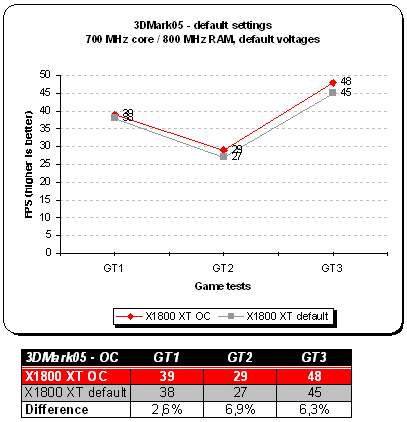
Please visit Beyond3D to read more about my overclocking issues.
We are closing in so to wrap everything up, I’ll start from the beginning. The long awaited SM3.0 support has finally landed on ATi cards. All X1K products support this shader model though obviously not every card will perform the same way. We’ve showed you how X1800 XT from PowerColor and X1800 XL from HiS stack up against each other and the older X800 XT. From technical standpoint, X1800 series of cards are highly advanced. Besides Shader Model 3.0, the biggest of all changes was the introduction of what ATi calls Ultra-Threading Dispatch Processor and Ring Bus. Considering these chips carry only 16 pixel pipelines, performance seems quite consistent and eloquent. Throw in additional 2 vertex shaders and we have 8 in total. Taking this flagship board for a long spin by benchmarking the latest and hottest games around the block reveals a lot about R520 architecture — changes that were made are effective and powerful. Although quite late, X1800 series has a lot of potential especially with the next generation of games. As for the product itself, PowerColor X1800 XT is something many will consider a good bang for the buck. Albeit it comes with weak game bundle and looks exactly like ATi’s reference design it might be a plus to some people. Whether you are upgrading or looking for a new killer video card, consider PowerColor as your brand. I’m sure many enthusiasts will choose their X1800 XT as their graphics powerhouse and they wont regret it.
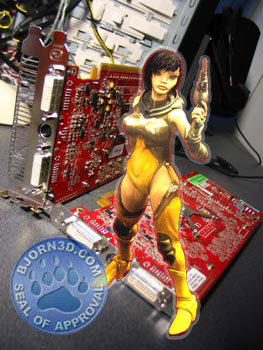
+ Great performer
+ Avivo technology
+ Stable and not so loud
+ 512 MB framebuffer Cons:
– Outdated and weak bundle
– Core OC could be higher
– Power hungry
– Dual bracket design
For outstanding performance PowerColor X1800 XT gets the rating of 8.5 (Very Good) out of 10 and Bjorn3D.com Seal of Approval Award.

 Bjorn3D.com Bjorn3d.com – Satisfying Your Daily Tech Cravings Since 1996
Bjorn3D.com Bjorn3d.com – Satisfying Your Daily Tech Cravings Since 1996
